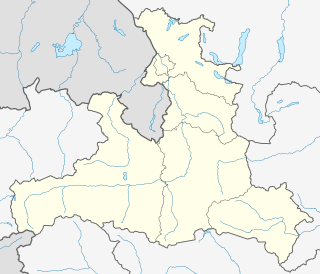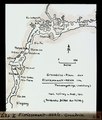Eisriesenwelt
| Eisriesenwelt
|
||
|---|---|---|
|
Eisriesenwelt, the lighting comes from magnesium torches (left behind an ice wall) |
||
| Location: | Tennengebirge near Werfen , Salzburg / Austria | |
| Height : | 1656 m above sea level A. | |
|
Geographic location: |
47 ° 30 '39.6 " N , 13 ° 11' 35.2" E | |
|
|
||
| Cadastral number: | 1511/24 | |
| Geology: | Dachstein Limestone | |
| Type: | Ice cave | |
| Discovery: | 1879 | |
| Show cave since: | 1920 | |
| Lighting: | Carbide lamps / magnesium torches | |
| Overall length: | 42 km | |
| Length of the show cave area: |
approx. 1 km | |
| Particularities: | largest ice cave in the world | |
| Website: | www.eisriesenwelt.at | |
The Eisriesenwelt is a cave system in the Tennengebirge in the state of Salzburg in Austria , near the town of Tenneck .
The Eisriesenwelt (also Posselthöhle , first description anonymously 1879, Posselt 1880; K. No. 1511/24) is the largest ice cave in the world with a total length of 42 km . It was discovered in 1879 by the Salzburg naturalist Anton von Posselt-Czorich . Today the cave is an excursion destination.
Location and description
The cave is located in the Tennengebirge above Wimm near Tenneck in Austria, about 50 km south of Salzburg.
The urn of the significantly involved researcher Alexander von Mörk , who died in the First World War , stands above a cave passage inside the cave, which extends over 42 kilometers into the mountain. Only the first kilometer is icy and can be viewed with a guide.
The entrance portal is 1640 m above sea level. A. After the Ice Palace there are no longer any connected ice sheets; the guided tour ends there. A steep trestle tunnel leads from the ice palace to the underground tunnel . This is followed by the Midgards . This passage is the largest in the cave (between 8 and 30 meters wide). From there branches branch off in all directions. The end of the cave is the New World at 1595 m.
The ice grows through the chimney effect in the cave, which in winter transports cold air masses up to about 1 km into the interior of the cave. The rock stores the cold until spring and when it gets warmer outside and the snow melts , water can seep through crevices and cracks in the rock into the cave and freeze to ice.
The interior of the cave also warms up in summer; 5–10 cm of the bottom ice cover melt away again. In the following spring everything grows back again. Overall, the ice isn't getting any less - it's actually getting a little more.
history
The cave was discovered in 1879 by the Salzburg naturalist Anton Posselt. At that time he succeeded in penetrating about 200 m into the interior of the cave. He couldn't go any further. The ice sheet was getting too steep for him; his equipment was too bad. He marked his turning point with a black cross on the rock, the Posselt cross . Afterwards the cave was largely forgotten again.
In 1913, some researchers, including Alexander von Mörk , managed to conquer the steepest section of the ice sheet, the Great Ice Wall . Alexander von Mörk was also the first researcher who dared to pass the Sturmsee , a small passage that was then under water. Behind it, he discovered a huge hall that was later named after him. In 1914, Alexander von Mörk had to go to the First World War. There he fell at the age of 27. His last will was to be buried in the ice giant world. This wish was granted to him and he was buried in the Alexander von Mörk Cathedral , which he had discovered in the mid-1920s .
After the end of the First World War, the Salzburg attorney Friedrich Oedl (1894–1969) pushed the research forward from 1919, with the support of his brother Franz Robert Oedl and Leopoldine Fuhrich . He built the first accommodation, the researcher hut .
The land owners of the Eisriesenwelt are the Austrian Federal Forests . The Salzburg Association for Speleology had agreed a provisional lease with them, which was converted into a long-term contract in 1928 after the establishment of its own Eisriesenwelt-Gesellschaft mbH (the first managing director was Oedl). The income is used to research and develop the cave, the federal forests (as landowners) receive an annual percentage of the entrance fees.
Development and Tourism
The first guided tours in the Eisriesenwelt took place in 1920. Today, a cable car brings up to 2,500 guests per day to the vicinity of the cave entrance ( Dr.-Friedrich-Oedl-Haus ), around 150,000 visitors a year. For the tour, visitors are given carbide lamps . The guides illuminate the approximately five ice figures with magnesium light.
Those wishing to visit should note that the ascent to the lower cable car station and from the mountain station of the cable car to the cave entrance or with the 1400 steps (700 up and 700 down again) of the cave tour requires a certain level of fitness. The tour lasts around 75 minutes. There is a ban on filming and photography inside the cave, which is justified by feared delays and their effects on the timing of the tours.
Today the Eisriesenwelt is usually open to visitors between May 1st and October 26th. In the winter months the cave entrance is not accessible due to the high alpine location and the danger of avalanches. The temperature in the cave usually stays below freezing point even in summer.
Ice stalagnate
Cave exit of the Eisriesenwelt with a view of the main Alpine ridge ( Hohe Tauern )
literature
- Robert Bouchal, Josef Wirth: Cave Guide Austria - Over 100 caves with sketches, plans, access descriptions and 150 photos . Pichler Verlag, Vienna 2001, ISBN 3-85431-234-2 , pp. 147-149.
Web links
Individual evidence
- ↑ a b Karl Georg Kreiter: Dr. Friedrich Oedl House. In: Namesake of the mountain huts - mountain huts and their history - what the names of these mountain huts tell us in the Alpine region. Accessed in 2010 .
- ↑ Info sheet , accessed on August 17, 2019








